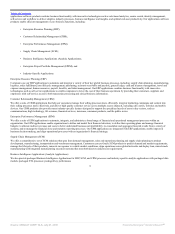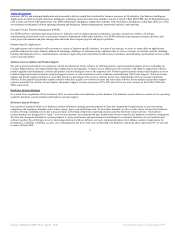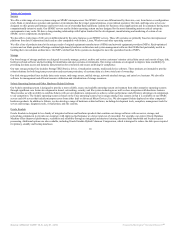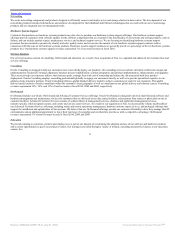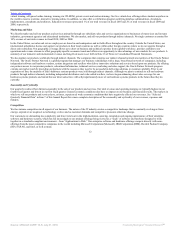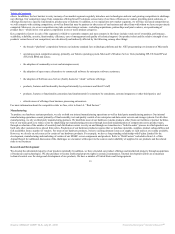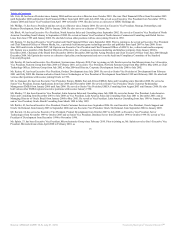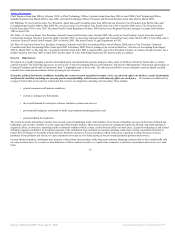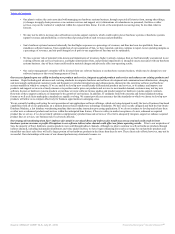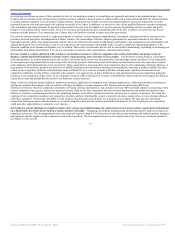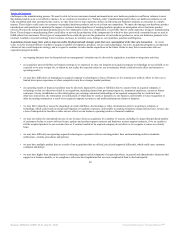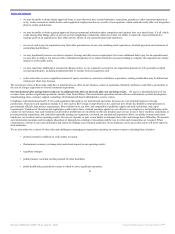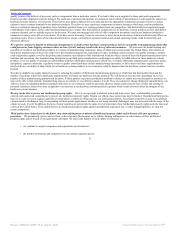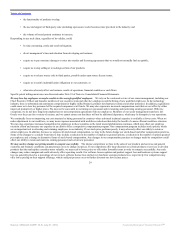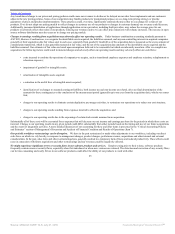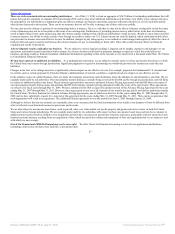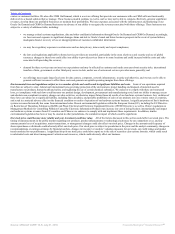Oracle 2009 Annual Report Download - page 22
Download and view the complete annual report
Please find page 22 of the 2009 Oracle annual report below. You can navigate through the pages in the report by either clicking on the pages listed below, or by using the keyword search tool below to find specific information within the annual report.
Table of Contents
• Our plans to reduce the costs associated with managing our hardware systems business, through expected efficiencies from, among other things,
(i) changes in supply chain processes or in customer services and support or (ii) eliminations of redundancies in personnel, facilities or other
services, may not be realized or completed within the expected time frame, if at all, or the anticipated cost savings may be less than what we
forecast.
• We may not be able to increase sales of hardware systems support contracts, which could result in lower hardware systems or hardware systems
support revenues and profitability, or slower than expected growth of such revenues and profitability.
• Sun’s hardware systems business historically has had higher expenses as a percentage of revenues, and thus has been less profitable, than our
standalone software business. Upon completion of our acquisition of Sun, we have reported, and may continue to report, lower operating margins as
a percentage of revenues, and our profit margin levels prior to our acquisition of Sun may not be sustainable.
• We face a greater risk of potential write-downs and impairments of inventory, higher warranty expenses than we had historically encountered in our
existing software and services businesses, and higher amortization from, and potential impairment of, intangible assets associated with our hardware
systems business. Any of these items could result in material charges and adversely affect our operating results.
• Our senior management’s attention will be diverted from our software business to our hardware systems business, which may be disruptive to our
software business or the overall management of Oracle.
Our success depends upon our ability to develop new products and services, integrate acquired products and services and enhance our existing products and
services. Rapid technological advances and evolving standards in computer hardware and software development and communications infrastructure, changing
and increasingly sophisticated customer needs and frequent new product introductions and enhancements characterize the enterprise software and hardware
systems markets in which we compete. If we are unable to develop new or sufficiently differentiated products and services, or to enhance and improve our
products and support services in a timely manner or to position and/or price our products and services to meet market demand, customers may not buy new
software licenses or hardware systems products or purchase or renew software license updates and product support or hardware systems support contracts.
Renewals of these support contracts are important to the growth of our business. In addition, IT standards from both consortia and formal standards-setting
forums as well as de facto marketplace standards are rapidly evolving. We cannot provide any assurance that the standards on which we choose to develop new
products will allow us to compete effectively for business opportunities in emerging areas.
We are currently building and testing the next generation of our applications software offerings, which are being designed to unify the best-of-business functional
capabilities from all of our applications on a modern Internet-based middleware technology foundation. We have also recently designed and built the Sun Oracle
Database Machine, a fast database warehousing machine that runs online transaction processing applications. If we do not continue to develop and release these
or other new or enhanced products and services within the anticipated time frames, if there is a delay in market acceptance of a new, enhanced or acquired
product line or service, if we do not timely optimize complementary product lines and services or if we fail to adequately integrate, support or enhance acquired
product lines or services, our business may be adversely affected.
Our strategy of transitioning from Sun’s indirect sales model to our mixed direct and indirect sales model may not succeed and could result in lower
hardware systems revenues or profits. Disruptions to our software indirect sales channel could affect our future operating results. Prior to our acquisition of
Sun, the majority of Sun’s hardware systems products were sold through indirect channels. Although we plan to continue to sell our hardware products through
indirect channels, including independent distributors and value added resellers, we have begun enhancing direct sales coverage for our hardware products and
intend that our direct sales force will sell a larger portion of our hardware products in the future than they do now. These direct sales efforts, however, may not be
successful. Our relationships with some of our channel partners may deteriorate because we
18
Source: ORACLE CORP, 10-K, July 01, 2010 Powered by Morningstar® Document Research℠


